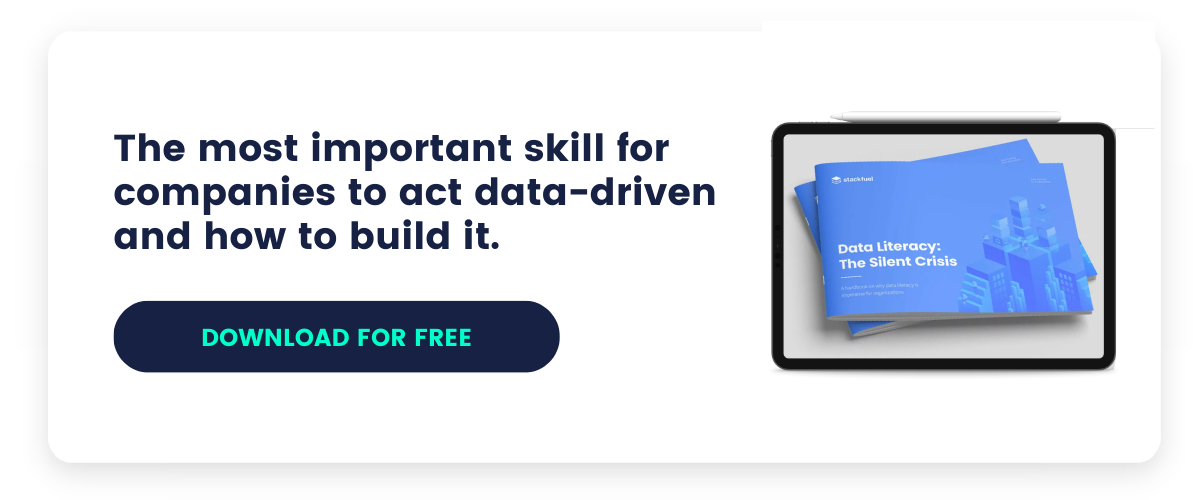A valuable ressouce: Data is known to be the oil of the 21st century. But just as oil must be refined before it becomes usable, data also gains its added value only through data analysis. The data information gained from data analysis is what we can work with and draw conclusions from.
Digitalization is subjecting our everyday lives and, beyond that, the entire working world to a digital transformation. This leads to the fact that the Data volume is growing enormously fast worldwide. More and more of our work processes are going digital, leaving their traces in the form of data in our systems, servers and hard drives.
By the way: Thanks to Education voucher you can even get further training in data analysis free of charge under certain conditions.

According to projections, the global volume of data will increase to 163 zettabytes by 2025. To give you a better idea of this amount, here's a comparison: The daily amount of data today is roughly equivalent to 350 times the weight of the Eiffel Tower. And to store the amount of data we produce every day, we would need more than 50 brains.
But no one could do anything with data in its raw form. They first have to be processed by applying methods such as the Data AnalysisThe knowledge is processed into information and then into knowledge. Only in this way you are in the position from this knowledge profitable insights that will help you get ahead. We'll tell you what data analysis is and how you can use it to get off to a vertical start in your digital future.
Definition: What is data analysis?
Data analysis is a ProcessIn this process, existing data is converted into a readable, analyzable form in order to gain information and ultimately knowledge from it in the final step. In doing so, you apply various statistical methods and procedures to identify trends and patterns, for example.
In order to derive real added value from your analysis, you then compare your findings with Visualizations vividly. So what's in it for you? Through the use of data analysis, you and your company can, for example, improve your Customers better understand and offer personalized products and services. But you can also internal processes optimize through the analysis of data and strategic decisions derive.
In the age of digitalization, companies produce huge amounts of data every day. Whether customer data in marketing, sensor data in industry or position data in logistics - companies need to extract information from all this available data in order to make the right decisions and remain competitive and improve their products.
Despite increasing digitization, many decision-making processes are susceptible to error, manipulation or bias. The use of data analytics therefore opens up enormous opportunities for companies to objective and informed decisions to make. As humans, we are all susceptible to cognitive biases and allow ourselves to be unconsciously influenced when making decisions.
We also tend to prefer to make choices again that were successful in other contexts without re-evaluating the situation and context. For example, we always order the same thing in a restaurant or prefer to watch a movie we already know and like rather than try something new. In our private lives, this behavior does us no harm. When it comes to business decisions, however, it's a different story.
So analyzing data helps you to stay objective and Misconceptions to avoid. The basis for your decisions are the insights you have gained, which you can clearly document in a report or dashboard in the form of figures and graphics.
Steps of data analysis: How to gain data insights?
Data analysis procedure:
- Define question
- Obtain data
- Prepare data
- Analyze data
- Communicate results
At the beginning there is a question
What would a win be without a challenge? The process of data analysis first starts with a problem that you get to solve. As Data Analyst departments approach you and report a problem. This could be, for example, that a certain target group in marketing is less willing to buy. Or that more contracts are being cancelled.
From this problem you must now create a Question which exactly describes the problem. So you first have to find out which data can provide the right insights with regard to the problem. If you formulate the question precisely, this can save you a lot of work in the further course.
How do you get the data?
The next step is the Data collection (English: Data Gathering). You need data for a data analysis. This data is available to you as raw data or even has to be collected specifically first. Companies usually have large amounts of data that can be made accessible for your analysis. Especially when data from different departments are combined, this creates great potential for deriving valuable or new insights.
That is why data must first be prepared
After the data is ready for your analysis, it must be saved in the Data cleaning (English: Data Cleaning) can be prepared. Your data can come from many different sources. This leads to a variety of structures and formats. Whether text, image or sensor data: You have to bring all data points into a uniform processing structure.
Missing data must also be added here and incorrect data removed. True to the motto "Garbage In, Garbage Out", this step is the basis for the quality of your analysis results. If the data is not well cleaned, you cannot derive any reliable insights from it. Therefore, this step is often the most time-consuming one in your work as a Data Analyst or Data Scientist. Data experts spend around 80 percent of their time cleaning and preparing data.
How is data analyzed?
Once your data base has been cleaned and prepared, you then move on to the actual analytical part of your work. Depending on the type of question, you filter your data, group and aggregate them, or compare them using statistical ratios such as the mean, the variance, or the standard error. Depending on the question, you adapt your approach.
Data analysis can help you answer the following questions:
- What happened?
- Why did something happen?
- What will happen?
A descriptive data analysis describes data from the past and provides an answer to the question "What happened?".
To uncover causes and correlations, you need to compare historical data. Here can be a diagnostic data analysis answer the question "Why did something happen?".
If you want to answer the question "What will happen?", a predictive data analysis predict future trends using machine learning and artificial intelligence.
Present results in a comprehensible and target group-oriented manner
Your collected information and the insights gained from it can only help you and your company if they are used and applied. Therefore, the final step of the data processing process is to successfully communicate your results to your target audience. The key to this is the Data Storytelling.
The focus of your presentation is on the question answered and the problem solved. Your storytelling is therefore always oriented to the target audience. Take into account what knowledge and skills the audience has and how they can best understand your results. Therefore, visualizations are also part of your convincing presentation. Depending on the question and the target group, different types of presentation such as bar charts or line diagrams are suitable.

Want to uncover secret treasures in your company's data to take your business further? Then take a look at our specialized, practice-oriented Training offer an. You want to do further education, but need help with financing? No problem! As a state-certified training provider, we can offer training free of charge. You can find out how this works for you here:
For companies: The Qualification Opportunities Act now with our free Webinar uncomplicated use
For employees: Qualification Opportunity Act
For job seekers: Now the Education voucher apply and get free advice
We'd love to help you become a data analytics professional and successfully equip you and your business for the data-driven age.
Sources
Gartner (2022): "Data and analytics support business decisions" [06.01.2022]





